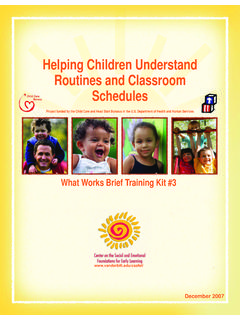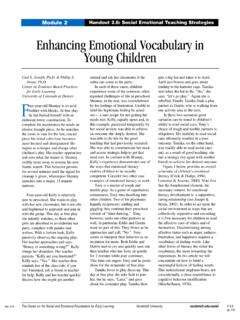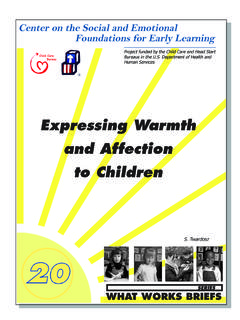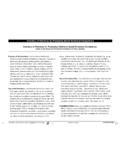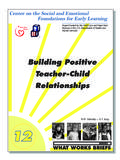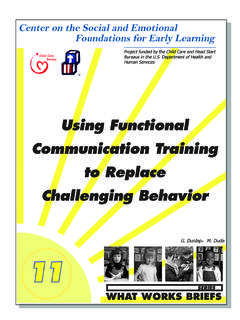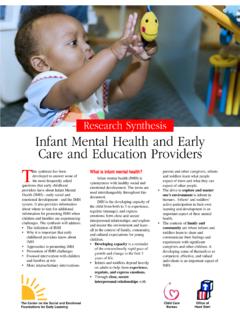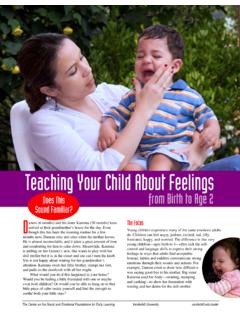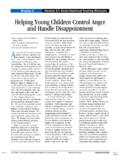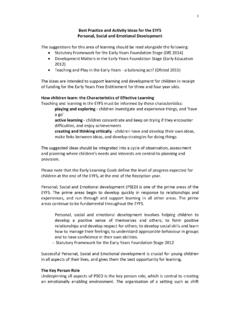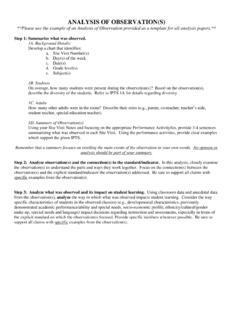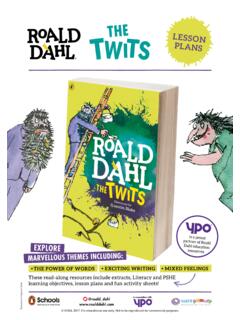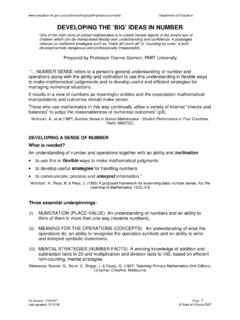Transcription of Using Books to Support Social Emotional Development
1 The Rainbow FishBy Marcus PfisterNorth South Books , 1992 Rainbow Fish is the most beautiful fish in the ocean. He thinks heis very special because of his sparkling scales, and refuses to sharehis scales with the other fish. His friends become upset when hedoesn t share and begin to ignore him. Rainbow Fish is very lonelyuntil he seeks advice from a wise octopus and discovers that he ismuch happier when he shares his beautiful scales with his friends.(Ages 3-8)Examples of activities that can be used while reading The Rainbow Fishand throughout theday to promote Social and Emotional Development : After children become familiar with the story, discuss the different emotions that the fish feelthroughout the story. Ask children how Rainbow Fish feels about his beautiful, sparklingscales. Why did the little blue fish want one of Rainbow Fish s scales?
2 How do they think theother fish felt when Rainbow Fish wouldn t play or share with them? Why did Rainbow Fishfeel lonely? Why was Rainbow Fish happy at the end of the book? How did the other fish feelwhen Rainbow Fish shared his glimmering scales with them? While reading the story, have children talk about times when they didn t feel like sharing. Askchildren how they would feel if they were Rainbow Fish. Would they want to share their prettyscales with their friends? What if they were Rainbow Fish s friends? How would they feel ifRainbow Fish didn t want to share his scales with them? Ask children what they can do whenthey don t want to share what they are playing with. For example, they might use a timer andtell their friend they can play with the toy in 5 minutes. Ask if they remember what RainbowFish did. He asked for help!
3 First he asked the starfish and then the wise octopus. Explain thatthey could do what Rainbow Fish did and ask a teacher or one of their friends for help. This isa great opportunity to discuss how it is sometimes really hard to share! Talk about the importance of friendship. Ask children what it means to be a good friend. Asthe children share their thoughts, write them on a sheet of paper decorated with fish friends (fish cut out of construction paper). Refer back to their list as you see children Using their fishfriend ideas throughout the day. Have a Be a Good Friend Day! so children can practice Using their friendship skillsthroughout the day. Refer back to their fish friend list to remind them of ideas for being agood NookUsing Books to Support Social Emotional DevelopmentThe Center on the Social and Emotional Foundations for Early Learning Child Care BureauOffice ofHead Start Book NookReading the same book for several days in a row is a great way to provide opportunities for infants,toddlers, and preschoolers to develop a sense of competence and confidence, which is an importantpart of Social and Emotional Development .
4 They become able to turn pages, point at and labelpictures, talk about the story, predict what will happen next, learn new vocabulary words, talk about their own experiences in relation to the story and even make up their own story! Try readingThe Rainbow Fishfor several days in a row and use some of the ideas , activities, and teachingopportunities listed below to enhance Social and Emotional skills. Remind children how the fish became upset and ignored Rainbow Fish when he would not share hisbeautiful, glimmering scales with them. When they did this, Rainbow Fish was very lonely and feltlike he didn t have any friends. Refer back to the list of fish friend ideas for being a good to the children that today they will be doing some fun activities related to being friends. Art: Ask the children if they remember what Rainbow Fish shared with the other fish in the ocean(his beautiful scales).
5 Tell them that they are going to work together and make their own RainbowFish with beautiful, glittery scales. Make a large fish shape on butcher paper. Using half circles madewith construction paper or paper plates cut in fourths, have children work together to makeshimmering, glittery fish scales just like Rainbow Fish had! They can decorate their scales withglitter, pictures, foil, stickers, markers, etc. Limit the number of materials to encourage children toshare and work together. As they are decorating their scales, point out how they are sharing andworking together like friends do. After they have finished decorating the scales, help children attacheach scale to the large fish shape. Be sure to attach only a small corner of the scale to the RainbowFish shape. The next time you read the story and get to the part where Rainbow Fish gives away hisscales, you can have children take a scale off of the big Rainbow Fish and put it on a smaller fishmade out of construction paper and taped around the large Rainbow Fish shape.
6 Block Area:Tell the children that they are going to build a pretend ocean with the blocks just likethe one that Rainbow Fish and his friends lived in. Help children put the blocks in a circle to makethe ocean. Explain that they are now going to go fishing in the ocean. Put metal fruit juice can lidswith pictures of the children glued to the top of the lids in the ocean (prepare the picture lidsahead of time). Using a fishing pole with a magnet, children can go fishing for friends . After theycatch a friend, they can do something special with their friend during the day. Talk to the childrenabout what kinds of things they can do with their friends. Remind them about the ideas on their fish friends list. At the end of the day, have children share what kinds of special things they didwith their : Explain to children that they are going to make a Rainbow Fish book about what it meansto be a good friend.
7 Have fish shapes cut out of different colored construction paper with I am agood friend when I .. written on each fish. Talk to children about what kinds of things a goodfriend might do. Have them think about their friends. What do their friends do that make them feelreally special? Help them write their thoughts on each fish. They can also draw pictures and decoratetheir fish pages. When they are finished, put all of the pages together to make a book. Read the bookduring large group time and then put it in the book area so children can read their Rainbow Fishbook throughout the book nook was developed by Angel Lee and Tweety Yates Friendshi
